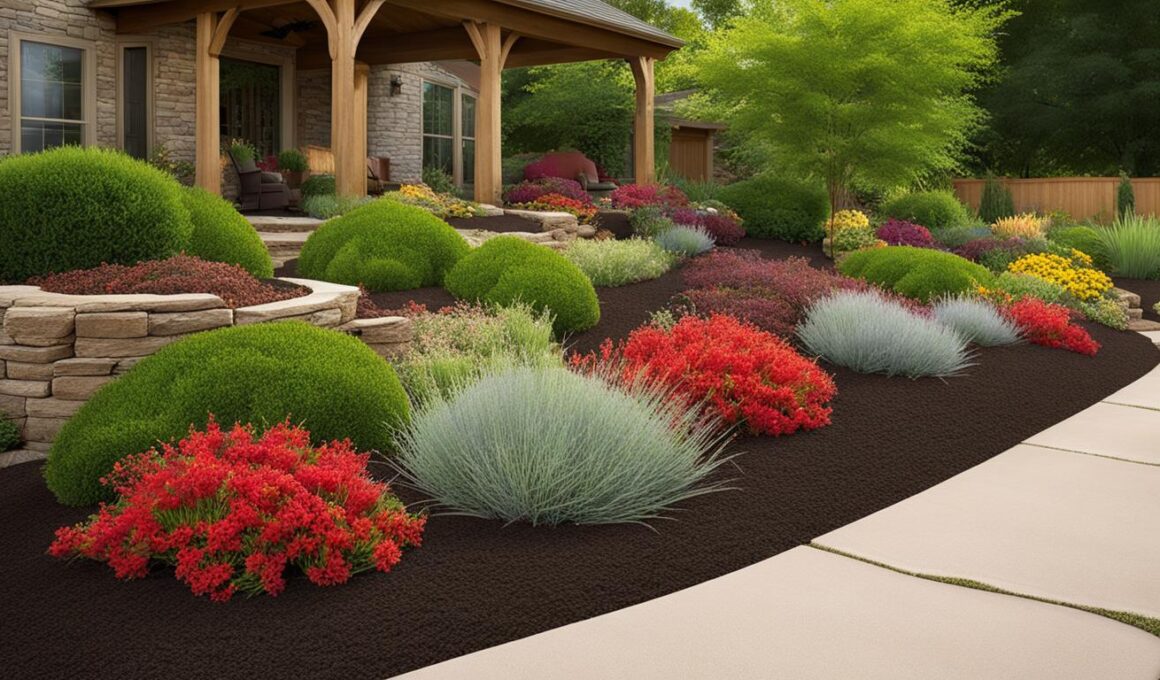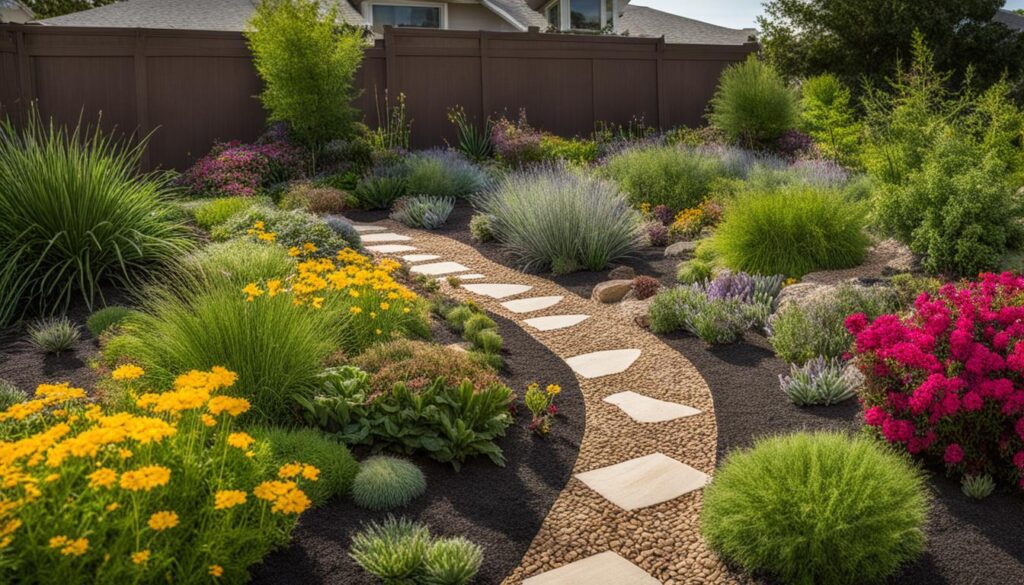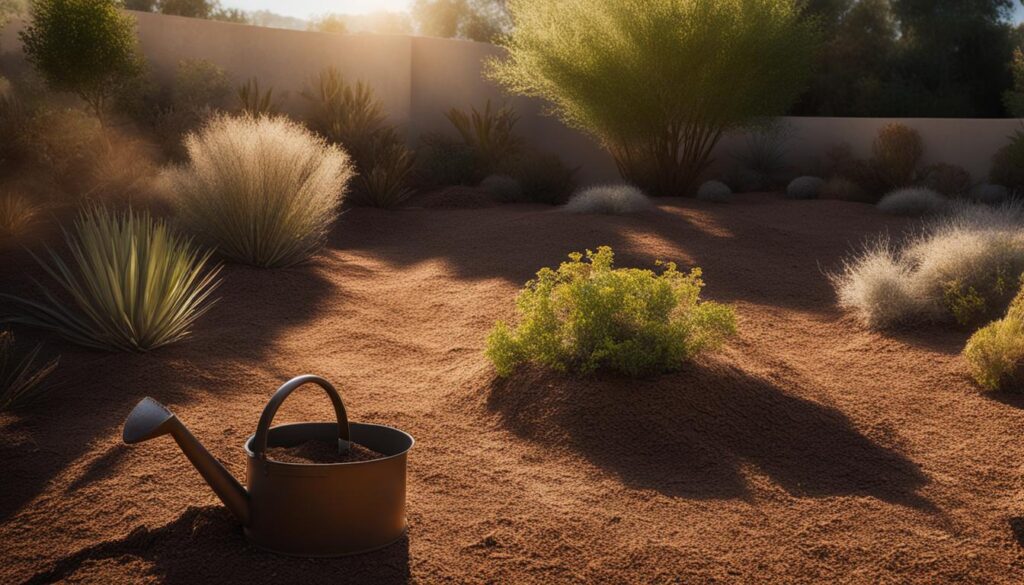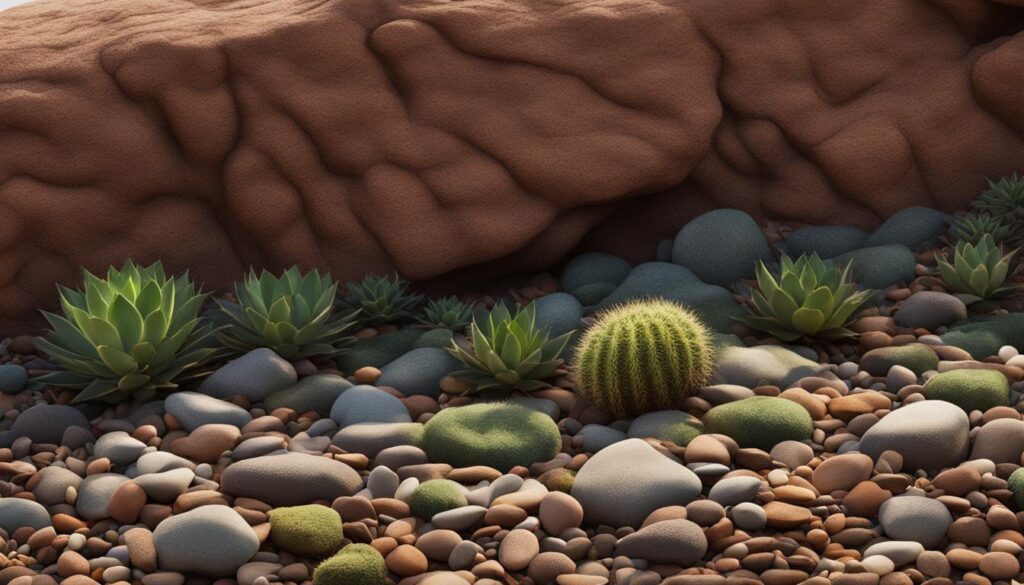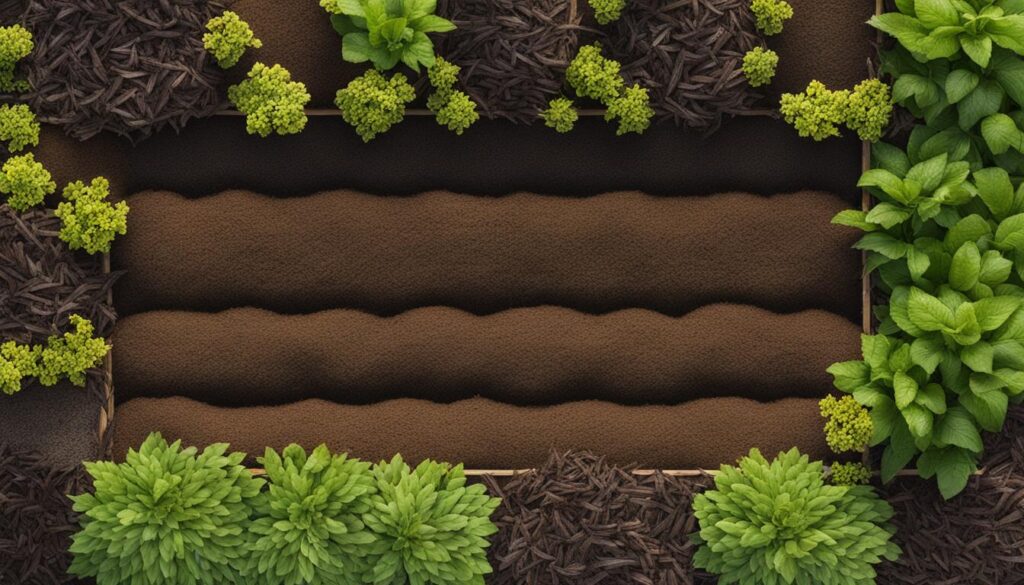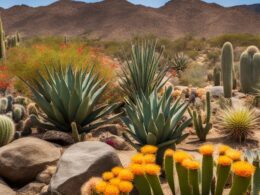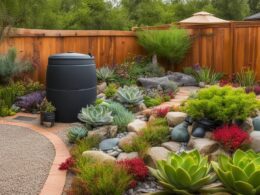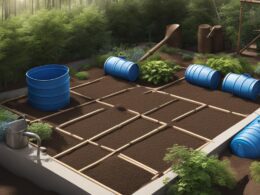Mulching is a key aspect of xeriscaping and plays a vital role in improving soil health. By selecting the right mulching methods, you can enhance the beauty and health of your landscape. Let’s explore some effective mulching methods for xeriscape soil improvement.
Key Takeaways:
- Selecting the right mulching methods is crucial for improving soil health in xeriscape gardens.
- Mulching offers a range of benefits, including suppressing weeds, reducing evapotranspiration, and improving drainage.
- Organic mulches, such as wood chips and grass clippings, contribute to building organic content in the soil.
- Inorganic mulches, like rock layers, provide similar benefits and add aesthetic appeal to the landscape.
- Proper mulching techniques, such as applying the right thickness and avoiding weed barriers, are essential for success.
Understanding Mulch and Its Benefits to Xeriscape Gardens
When it comes to maintaining a healthy xeriscape garden, understanding mulch and its benefits is essential. Mulch is a protective layer placed on bare soil in xeriscape gardens that offers a range of advantages. By mimicking the natural processes found in a forest floor, mulching provides numerous benefits to your garden.
Firstly, mulching helps suppress weeds by blocking sunlight and preventing weed growth. This reduces the need for herbicides and manual weeding, saving you time and effort. Additionally, mulch acts as an insulating layer, reducing evapotranspiration and helping to conserve water. It slows down the evaporation of moisture from the soil, ensuring that your plants receive the water they need.
Mulch also plays a crucial role in controlling soil erosion. By creating a barrier between the soil and heavy rain, it helps prevent soil particles from being washed away. This is especially important in xeriscape gardens where water scarcity is a concern. Furthermore, mulching improves the overall aesthetics of your garden by providing a clean and uniform look. It adds visual interest to your landscape and can be used to create defined pathways or borders.
Did You Know? Organic mulches contribute to building organic content in the soil, improving its texture and structure.
In summary, mulching offers a range of benefits to xeriscape gardens. It helps suppress weeds, reduces evapotranspiration, controls erosion, improves drainage, and enhances the aesthetics of your garden. By understanding the role that mulch plays and the benefits it provides, you can make informed decisions when it comes to selecting and applying mulch in your xeriscape garden.
Organic Mulching Options for Xeriscape Gardens
When it comes to xeriscape gardens, choosing the right mulching options is crucial for soil improvement and overall landscape health. Organic mulches provide numerous benefits and help create a sustainable and visually appealing garden. Here are some popular organic mulching options for xeriscape gardens:
Wood Chips:
Wood chips are a common choice for mulching in xeriscape gardens. They help retain moisture, suppress weeds, and gradually break down to improve the soil’s organic matter content. Wood chips also provide insulation, protecting plant roots from extreme temperatures. However, it’s important to replenish wood chips regularly to maintain their effectiveness.
Bark:
Bark mulch is another organic option that offers similar benefits to wood chips. It helps conserve moisture, control weed growth, and adds an attractive texture to the landscape. Bark mulch also improves soil structure and fertility over time. Make sure to choose bark mulch from sustainable sources to minimize the environmental impact.
Straw:
Straw is a popular mulching option for vegetable gardens in xeriscape landscapes. It provides excellent insulation, conserves moisture, and acts as a weed barrier. Straw also breaks down slowly, adding organic matter to the soil and enhancing its fertility. However, it’s important to lay a thick layer of straw to prevent weed growth effectively.
| Mulching Option | Benefits |
|---|---|
| Wood Chips | Retains moisture, suppresses weeds, improves organic matter content |
| Bark | Conserves moisture, controls weed growth, enhances soil structure |
| Straw | Insulates soil, conserves moisture, acts as a weed barrier |
These organic mulching options not only provide immediate benefits but also contribute to long-term soil health and sustainability in xeriscape gardens. Experiment with different organic materials to find the mulch that suits your landscape’s needs and aesthetics.
Inorganic Mulching Options for Xeriscape Gardens
When it comes to mulching in xeriscape gardens, organic options are not the only choice. Inorganic mulches, such as rock layers or plastics, can also provide numerous benefits. They offer similar advantages to organic mulches, including weed suppression, moisture retention, and soil temperature regulation. Choosing between organic and inorganic mulches depends on personal preference and the desired aesthetic of your landscape.
Rock mulch, for example, is a popular choice for xeriscape gardens. It offers durability and low-maintenance while providing an aesthetically pleasing look to the landscape. Rock mulch can resist degradation, doesn’t attract pests, and can last for many years. However, it’s important to consider the specific needs of your plants and the climate in your area before opting for rock mulch. It is worth noting that rock mulch can absorb and radiate heat, which may affect soil temperature and plant health.
Plastic mulch is another inorganic option that can be used in xeriscape gardens. It is an effective way to suppress weeds, conserve moisture, and regulate soil temperature. Plastic mulch is commonly used in vegetable gardens as it creates favorable microclimates for the plants. However, it may not be suitable for all types of plants or for landscapes where aesthetics are a priority. Always consider the specific requirements of your garden before choosing plastic mulch.
| Mulch Type | Advantages | Disadvantages |
|---|---|---|
| Rock Mulch | Durable, low-maintenance, aesthetically pleasing | Potential heat absorption and radiating, limited organic matter contribution |
| Plastic Mulch | Weed suppression, moisture conservation, soil temperature regulation | Not suitable for all plants, may not be visually appealing |
When deciding on the inorganic mulching option for your xeriscape garden, it’s crucial to weigh the pros and cons based on your specific needs and preferences. Consider factors such as plant requirements, climate conditions, and desired aesthetics to make an informed decision. Remember, the goal of mulching in a xeriscape garden is to enhance the health and beauty of your landscape while conserving water and minimizing maintenance.
Pros and Cons of Wood Mulch for Xeriscape Gardens
Wood mulch, such as wood chips or bark, is a popular choice for xeriscape gardens due to its numerous benefits. However, like any other mulching option, wood mulch has its pros and cons that you should consider before incorporating it into your landscape.
Pros of Wood Mulch
- Effective weed suppression: Wood mulch forms a thick barrier that helps prevent weeds from germinating and growing in your garden. This reduces the need for manual weeding and saves time and effort.
- Moisture retention: Wood mulch acts as a protective layer, reducing evaporation and helping the soil retain moisture. This is especially beneficial in xeriscape gardens, where water conservation is a priority.
- Sustainable and organic: Wood mulch is a natural and sustainable option that can be sourced from recycled wood or byproducts of the lumber industry. It adds organic matter to the soil as it breaks down, improving its fertility over time.
Cons of Wood Mulch
- Decomposition and replacement: Wood mulch breaks down over time due to natural processes and weather conditions. This means that it may need to be replenished more frequently compared to other mulching options.
- Pest attraction: Wood mulch can provide a favorable environment for pests, such as termites and ants, if not properly managed. To prevent pest infestations, it’s essential to regularly monitor the mulch and take appropriate measures if any issues arise.
- Acidification of soil: Some types of wood mulch, such as pine bark or cedar chips, can slightly acidify the soil over time. While this can benefit certain acid-loving plants, it may not be suitable for plants that prefer neutral or alkaline soil.
Considering the pros and cons, wood mulch can be an excellent choice for xeriscape gardens, particularly if you prioritize weed suppression, moisture retention, and sustainability. However, it’s crucial to monitor its decomposition, manage pests effectively, and ensure it doesn’t negatively affect the pH balance of your soil. By weighing the advantages and disadvantages, you can make an informed decision on whether wood mulch is the right option for your xeriscape garden.
| Pros | Cons |
|---|---|
| Effective weed suppression | Decomposition and replacement |
| Moisture retention | Pest attraction |
| Sustainable and organic | Acidification of soil |
Pros and Cons of Rock Mulch for Xeriscape Gardens
If you’re looking for a durable and low-maintenance mulching option for your xeriscape garden, rock mulch is worth considering. Rock mulch, also known as gravel mulch, offers several benefits but also has its drawbacks. Let’s explore the pros and cons of using rock mulch in your xeriscape gardens.
Pros of Rock Mulch
Rock mulch provides excellent durability and longevity, making it a popular choice for xeriscape gardens. Unlike organic mulches that break down over time, rock mulch can withstand harsh weather conditions and retain its appearance for many years. Its ability to resist degradation can save you time and effort in replacing mulch regularly.
Another advantage of rock mulch is its low-maintenance nature. Once applied, it requires minimal upkeep compared to organic mulches. You don’t need to worry about potential pest issues or the need for frequent replacement. This makes rock mulch a convenient option for busy gardeners or those who prefer a low-maintenance landscape.
Cons of Rock Mulch
One drawback of using rock mulch is its impact on soil temperature. Rocks can absorb and radiate heat, potentially raising the temperature of the soil. This can be problematic for plants that prefer cooler soil conditions. It’s essential to consider the specific needs of your plants and the climate in your area before opting for rock mulch.
Additionally, while rock mulch suppresses weeds effectively, it can make it challenging to plant or remove existing plants. The rocks can hinder digging and interfere with plant root systems. This lack of flexibility may limit your ability to make changes to your landscape design in the future.
| Pros | Cons |
|---|---|
| Durable and long-lasting | Impacts soil temperature |
| Low-maintenance | Limited planting flexibility |
As you consider different mulching options for your xeriscape garden, weigh the pros and cons of rock mulch. It can provide durability and low-maintenance benefits, but it’s essential to ensure it aligns with the specific needs of your plants and the climate in your area. By carefully evaluating the advantages and disadvantages, you can make an informed decision about whether rock mulch is the right choice for your xeriscape garden.
The Importance of Proper Mulching Techniques
In xeriscape gardens, proper mulching techniques are crucial for maintaining soil health and conserving water. By following these techniques, you can ensure that your mulch effectively suppresses weeds, retains moisture, and promotes the overall health of your plants.
Applying the Right Amount of Mulch
When mulching in xeriscape gardens, it’s important to apply a sufficient layer of mulch to achieve the desired benefits. A layer around 3 inches thick is generally recommended. This thickness helps to suppress the growth of weeds by blocking sunlight and also prevents excessive evaporation of moisture from the soil.
Avoiding Weed Barriers
While it may be tempting to use weed barriers under your mulch, it’s best to avoid them in xeriscape gardens. Weed barriers can impede the circulation of air and water in the soil, inhibiting the growth of beneficial organisms and the absorption of moisture by plant roots. Instead, focus on properly preparing the soil before mulching and using an adequate layer of mulch to prevent weed growth.
Maintaining Proper Mulch Depth
Over time, organic mulches can decompose and break down, reducing their effectiveness. It’s important to regularly monitor the mulch depth and replenish it as needed. By doing so, you can ensure that your mulch continues to provide the necessary weed suppression and moisture retention benefits for your xeriscape garden.
| Benefits of Proper Mulching Techniques | Challenges of Improper Mulching Techniques |
|---|---|
| Suppresses weed growth | Attracts pests if mulch is not properly managed |
| Retains moisture in the soil | Can smother plant roots if mulch is too thick |
| Improves soil health and fertility | Can hinder air and water circulation if weed barriers are used |
| Enhances the aesthetics of the garden | Reduces the effectiveness of mulch if not regularly replenished |
By implementing proper mulching techniques in your xeriscape garden, you can create a healthy and visually appealing landscape while promoting water conservation and reduced maintenance.
Mulching Tips for Healthy Xeriscape Soils
Mulching is an effective method for maintaining healthy xeriscape soils. Here are some tips to help you achieve optimal results:
1. Choose the Right Mulch
When selecting mulch for your xeriscape garden, consider the specific needs of your plants and the climate in your area. Organic mulches, such as wood chips or bark, are great options for improving soil health and retaining moisture. Inorganic mulches, like rock or plastic, can provide durability and low-maintenance benefits. Evaluate the pros and cons of each type to make an informed decision.
2. Apply an Adequate Layer
To maximize the benefits of mulching, apply a sufficient layer of mulch. Aim for a depth of approximately 3 inches, ensuring that the soil is adequately covered. This thickness helps suppress weeds, regulate soil temperature, and retain moisture, promoting healthy root development and conserving water.
3. Mind Your Mulch Maintenance
Regularly monitor and maintain your mulch to keep your xeriscape soil healthy. Check for any signs of weed growth and remove them promptly. Keep an eye out for mulch that has decomposed or thinned out over time and replenish it as needed. By maintaining your mulch layer, you can continue to enjoy the benefits it provides to your xeriscape garden.
By following these mulching tips, you can ensure the health and vitality of your xeriscape soils. Remember to choose the right mulch, apply an adequate layer, and perform regular maintenance to optimize the benefits. With proper mulching techniques, your xeriscape garden will thrive while conserving water and reducing maintenance.
| Mulching Tips | Description |
|---|---|
| Choose the Right Mulch | Select organic or inorganic mulch based on plant needs and climate. |
| Apply an Adequate Layer | Ensure a 3-inch thickness for effective weed suppression and moisture retention. |
| Mind Your Mulch Maintenance | Regularly check for weed growth and replenish decomposed mulch as needed. |
“Mulching is a vital part of maintaining healthy xeriscape soils. By following these tips, you can create an environment that promotes plant growth and conserves water.” – Xeriscape Expert
Mulching Best Practices for Xeriscape Gardens
When it comes to mulching in xeriscape gardens, following best practices is essential to maximize its benefits. By implementing these effective mulching methods, you can ensure the health and vitality of your landscape while conserving water and reducing maintenance.
Proper Mulch Depth
One of the key factors in successful mulching is applying the proper depth of mulch. For xeriscape gardens, it is recommended to apply a layer of mulch approximately 3 inches deep. This depth provides sufficient coverage to suppress weeds and retain moisture without smothering the plant roots.
Spacing Around Plants
When mulching around plants, it’s important to leave a small space around the base of each plant. This space allows for air circulation and prevents moisture buildup, reducing the risk of fungal diseases. Avoid piling mulch directly against the stems or trunks of plants, as it can lead to rot or pest infestations.
Regular Mulch Maintenance
Mulch should be replenished regularly to maintain its effectiveness. Over time, organic mulches break down and decompose, so it’s important to check the depth of the mulch layer and add more as needed. By doing so, you can ensure that your xeriscape garden continues to receive the benefits of mulching, such as weed suppression and moisture retention.
Choose the Right Mulch
When selecting mulch for your xeriscape garden, consider the specific needs of your plants and the aesthetic you want to achieve. Organic mulches, such as wood chips or straw, provide additional benefits by improving soil health and fertility. Inorganic mulches, like decorative rocks or gravel, offer a low-maintenance option with long-lasting durability. Choose the mulch that best suits your garden’s requirements and personal preferences.
By following these mulching best practices, you can create a healthy and thriving xeriscape garden. From proper mulch depth to regular maintenance, these methods will help you maximize the benefits of mulching while promoting sustainable soil improvement.
Ideas for Mulching Combinations in Xeriscape Gardens
When it comes to mulching in xeriscape gardens, the combination of different mulching materials can add visual interest and enhance the overall aesthetics of your landscape. By mixing organic and inorganic mulches, you can create contrasting textures, colors, and functional benefits. Here are some ideas for mulching combinations to consider:
Lush Green Combination
Create a lush and vibrant look in your xeriscape garden by combining grass clippings with decorative rocks or wood chips. The green grass clippings will provide organic matter and help retain moisture in the soil, while the rocks or wood chips will add a natural, earthy element to the overall design.
Textural Contrast Combination
For a visually striking effect, combine fine-textured mulches like pine needles or straw with coarse-textured mulches such as bark or wood chips. This combination will not only add visual interest but also provide different levels of moisture retention and weed suppression.
Colorful Combination
Add a splash of color to your xeriscape garden by mixing mulches with different hues. Consider combining redwood chips with decorative pebbles or stones to create a visually appealing contrast. This combination will not only enhance the overall aesthetics but also provide the functional benefits of organic and inorganic mulches.
Remember to choose mulching combinations that complement the overall design and theme of your xeriscape garden. Experiment with different materials, textures, and colors to create a visually appealing and functional landscape that suits your preferences and environmental goals.
| Mulching Combination | Main Benefits |
|---|---|
| Lush Green Combination | – Adds organic matter to the soil – Retains moisture – Provides a natural look |
| Textural Contrast Combination | – Creates visual interest – Provides varying levels of moisture retention and weed suppression |
| Colorful Combination | – Adds visual appeal – Provides functional benefits of organic and inorganic mulches |
Mulching and Sustainable Soil Improvement
Mulching is not only beneficial for xeriscape gardens but also plays a crucial role in sustainable soil improvement. By incorporating organic mulches into your garden, you can contribute to the long-term health and fertility of the soil. Organic mulches, such as wood chips, bark, or straw, break down over time, adding organic matter to the soil and improving its structure.
One of the key advantages of mulching is its ability to enhance water-holding capacity. By providing a protective layer on the soil surface, mulch helps reduce evaporation and slows down moisture loss, allowing plants to access water for a longer period. This not only conserves water but also promotes deep root growth and improves overall plant health.
In addition to water conservation, mulching also aids in weed suppression. The layer of mulch acts as a barrier, preventing weed seeds from germinating and competing with your plants for nutrients and water. This reduces the need for chemical weed control methods, making your garden more environmentally friendly.
Furthermore, mulching helps regulate soil temperature. In hot climates, mulch can keep the soil cooler by shielding it from direct sunlight. Conversely, in colder regions, mulch acts as insulation, preventing rapid temperature fluctuations that can harm plant roots. By creating a more stable soil environment, mulch supports healthy root development and overall plant growth.
Table: Benefits of Mulching for Xeriscape Gardens
| Benefits | Description |
|---|---|
| Improved Soil Health | The breakdown of organic mulches adds nutrients and improves soil structure. |
| Water Conservation | Mulch reduces evaporation, allowing plants to access water for longer periods. |
| Weed Suppression | Mulch acts as a barrier, preventing weed seeds from germinating. |
| Temperature Regulation | Mulch helps maintain a more stable soil temperature, protecting plant roots. |
What Are the Benefits of Using Gravel Mulch in Xeriscape Soil Improvement?
When it comes to xeriscape soil improvement, mastering gravel mulch application is key. Using gravel mulch in xeriscape gardens helps conserve water, control weed growth, and regulate soil temperature. The benefits of using gravel mulch go beyond just aesthetics, making it an essential component in creating sustainable and low-maintenance landscapes.
Conclusion
Effective mulching methods are crucial for xeriscape soil improvement. By understanding the benefits of mulching and considering different organic and inorganic options, you can enhance the health and beauty of your landscape. Following proper mulching techniques, such as applying a sufficient layer of mulch and avoiding weed barriers, is essential for optimal results.
Experimenting with mulching combinations can add visual interest to your xeriscape garden. By mixing different organic or inorganic mulches, you can create contrasting textures and colors that enhance the overall aesthetic. Whether you choose wood chips with decorative rocks or pine needles for weed suppression, these combinations can contribute to a visually appealing and functional garden.
Mulching not only improves soil health but also promotes sustainability in xeriscape gardens. Using organic mulches helps build organic matter in the soil, increasing fertility and water-holding capacity. Additionally, mulching reduces the need for chemical weed control and conserves water by minimizing evapotranspiration. With the right mulching methods, your xeriscape garden can thrive while being environmentally friendly.





